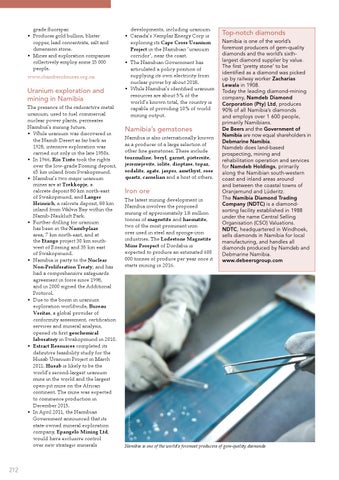www.chamberofmines.org.na
Uranium exploration and mining in Namibia The presence of the radioactive metal uranium, used to fuel commercial nuclear power plants, permeates Namibia’s mining future. • While uranium was discovered in the Namib Desert as far back as 1928, intensive exploration was carried out only in the late 1950s. • In 1966, Rio Tinto took the rights over the low-grade Rössing deposit, 65 km inland from Swakopmund. • Namibia’s two major uranium mines are at Trekkopje, a calcrete deposit 80 km north-east of Swakopmund, and Langer Heinrich, a calcrete deposit, 80 km inland from Walvis Bay within the Namib-Naukluft Park. • Further drilling for uranium has been in the Namibplaas area, 7 km north-east, and at the Etango project 30 km southwest of Rössing and 35 km east of Swakopmund. • Namibia is party to the Nuclear Non-Proliferation Treaty, and has had a comprehensive safeguards agreement in force since 1998, and in 2000 signed the Additional Protocol. • Due to the boom in uranium exploration worldwide, Bureau Veritas, a global provider of conformity assessment, certification services and mineral analysis, opened its first geochemical laboratory in Swakopmund in 2010. • Extract Resources completed its definitive feasibility study for the Husab Uranium Project in March 2011. Husab is likely to be the world’s second-largest uranium mine in the world and the largest open-pit mine on the African continent. The mine was expected to commence production in December 2015. • In April 2011, the Namibian Government announced that its state-owned mineral exploration company, Epangelo Mining Ltd, would have exclusive control over new strategic minerals
212
developments, including uranium. • Canada’s Xemplar Energy Corp is exploring its Cape Cross Uranium Project in the Namibian ‘uranium corridor’, near the coast. • The Namibian Government has articulated a policy position of supplying its own electricity from nuclear power by about 2018. • While Namibia’s identified uranium resources are about 5% of the world’s known total, the country is capable of providing 10% of world mining output.
Namibia’s gemstones Namibia is also internationally known as a producer of a large selection of other fine gemstones. These include tourmaline, beryl, garnet, pietersite, jeremejevite, iolite, dioptase, topaz, sodalite, agate, jasper, amethyst, rose quartz, carnelian and a host of others.
Iron ore The latest mining development in Namibia involves the proposed mining of approximately 1.8 million tonnes of magnetite and haematite, two of the most prominent iron ores used in steel and sponge-iron industries. The Lodestone Magnetite Mine Prospect of Dordabis is expected to produce an estimated 600 000 tonnes of produce per year once it starts mining in 2016.
Top-notch diamonds Namibia is one of the world’s foremost producers of gem-quality diamonds and the world’s sixthlargest diamond supplier by value. The first ‘pretty stone’ to be identified as a diamond was picked up by railway worker Zacharias Lewala in 1908. Today the leading diamond-mining company, Namdeb Diamond Corporation (Pty) Ltd, produces 90% of all Namibia’s diamonds and employs over 1 600 people, primarily Namibians. De Beers and the Government of Namibia are now equal shareholders in Debmarine Namibia. Namdeb does land-based prospecting, mining and rehabilitation operation and services for Namdeb Holdings, primarily along the Namibian south-western coast and inland areas around and between the coastal towns of Oranjemund and Lüderitz. The Namibia Diamond Trading Company (NDTC) is a diamondsorting facility established in 1988 under the name Central Selling Organisation (CSO) Valuations. NDTC, headquartered in Windhoek, sells diamonds in Namibia for local manufacturing, and handles all diamonds produced by Namdeb and Debmarine Namibia. www.debeersgroup.com
PAUL VAN SCHALKWYK
grade fluorspar. • Produces gold bullion, blister copper, lead concentrate, salt and dimension stone. • Mines and exploration companies collectively employ some 15 000 people.
Namibia is one of the world’s foremost producers of gem-quality diamonds
